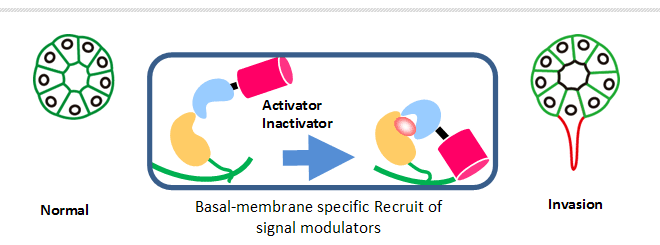|
HOME > Proposed research projects > 2012-2013: Proposed research projects 24
 2012-2013: Proposed research project 24Establishment of a cell invasion model and fluorescent imaging in organoid culture
Purpose of the Research ProjectPolarity is the word used to express uneven distribution of proteins and lipids. In the case of proteins, however, it is also required to consider their activity, not only their localization. Small GTPases work as intracellular molecular switches, and ignite their downstream signaling molecules upon perception of external or internal cues. Small GTPases which are GTP-bound but not GDP-bound, are able to bind to and activate effector proteins. Raichu is a biosensor based on the principle of Förster resonance energy transfer (FRET), which detects the activation pattern of small GTPases in living cells. We improved the existing FRET biosensors for Rho family GTPases and achieved stable epithelial expression for long enough to establish apico-basal polarity. This enabled us to generate a quantitative map of Rho-family GTPase activation during cystogenesis. Moreover, through the use of techniques to induce activation or inactivation of the small GTPase Rac1 in different stages of polarity maturation, we are now able to propose a novel model for Rac1 regulation during cystogenesis. During this course of experiments, we found difficulty in recruiting protein-of-interest to the limited domain of the plasma membrane. In this study, we aim to set up the system to translocate proteins to the specific membrane domain, especially at the basal domain, in the living cysts. Content of the Research ProjectBy reviewing the literature on protein localization in a 3-dimensional structure, I am going to develop a basal-domain specific recruiting system. One candidate is proteins forming focal adhesion complexes. Although it has been well studied in 2-dimensional cultured cells that focal adhesion complexes are important for cell-substrate adhesion, the location of these complexes in the cells in the 3-dimensional structure has not been shown. Since the basal membrane is facing a substrate rich in ligands for integrins, it is likely that adhesion related proteins are recruited to that area. Protein localization will be confirmed by observing fluorescent proteins. For inducible manipulation of proteins, a rapamycin-based FRB-FKBP hetero-oligomer system or an AID plant ubiquitination system will be use. Expected Research Achievements and Scientific SignificanceMalignant tumor cells invade and metastasize to other organs, while benign tumor cells do not. Since invasion is defined as infiltration through the basal membrane, it is important to investigate the events at the basal membrane. If a basal-membrane specific recruiting system is established, it becomes possible to manipulate signaling events at the basal membrane. Moreover, this system can be applied to various proteins, including small GTPases and kinases. As some growth factors initiate the first process of invasion, it also helps to investigate the molecules as a means to prevent invasion.
|








